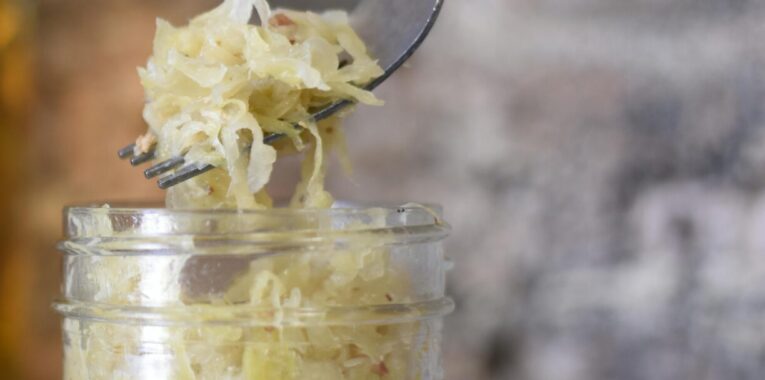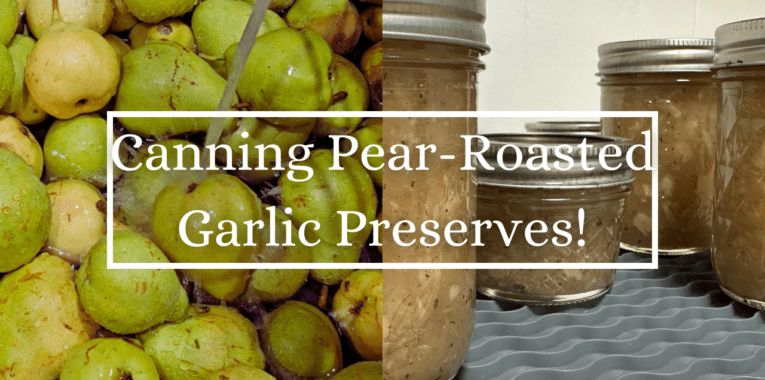It’s almost St. Patrick’s Day and that means cabbage will be going on sale at grocery stores! This is a great opportunity to purchase a couple of extra heads of cabbage and make sauerkraut! Homemade sauerkraut can be canned, but it can also store in your refrigerator for months. I prefer to store mine in the refrigerator if possible to avoid heating and potentially killing the naturally-occurring probiotics.
Why Make Homemade Sauerkraut?
Homemade sauerkraut differs from store-bought in three important ways:
- Pasteurization/canning – most store-bought krauts are treated with heat to eliminate bacteria culture before being canned and are heated during the canning process. Both of which compromise the naturally-formed probiotics that make sauerkraut so good for you to begin with!
- Preservatives – synthetic preservatives (i.e., chemicals) that are added into foods have been linked to heart issues and other health concerns.
- Pickled vs. fermented – another thing to watch out for in store-bought sauerkraut is sauerkraut that isn’t actually fermented but is pickled instead! The ingredients in a fermented sauerkraut should be cabbage, salt, and maybe water, but definitely no vinegar.
Because sauerkraut is so easy to make, you won’t go back to store-bought!
As an Amazon Affiliate, I earn from qualifying purchases.
What Do I Need to Make Sauerkraut?
You will need jars, lids, cabbage, salt, a tool to tamp the kraut down, and a weight that will fit into your jar(s).
- Stainless Steel Sauerkraut Tamper – I love this tamper! It is stainless steel, so it won’t retain flavors or harmful bacteria and is dishwasher safe! You can also use a wooden spoon to tamp the kraut down, but I really recommend investing in a tamper.
- Lids for wide-mouth jars – Standard, two-piece mason jar lids will work, but you will need to open your fermenting jars daily to “burp” the jar and allow the fermenting gases to escape. That’s why I like using lids designed for fermenting! I can truly set-and-forget because the lids will allow gases out without allowing contaminants in.
- Weights for wide-mouth jars and weights for regular-mouth jars – If you’re packing your sauerkraut into a wide-mouth jar, you can use a clean, water-filled, quarter-pint jar to act as a weight. However, if you’re using a regular-mouth jar or if you’re going to be fermenting very often, I really recommend purchasing weights designed for fermenting. They’re so easy to use, easy to clean, and don’t require using a jar that you could be canning in!
Recipe Video
Instructions
- Remove outer cabbage leaves, reserving a couple. Wash the reserved leaves and the cabbages well.
- Chop 5 pounds of cabbage into chunks that will fit in your food processor chute.
- Attached your shredding plate to your food processor and shred all 5 pounds of cabbage.
- Add cabbage to large bowl.
- Sprinkle 3 tablespoons of canning and pickling salt onto cabbage.
NOTE: You can use any salt you have on hand–just make sure it isn’t iodized and doesn’t contain any anti-caking agents. - Massage the salt into the cabbage until the cabbage begins producing a liquid.
- Let sit for 15 minutes.
- After 15 minutes, pack cabbage into glass mason jar(s).
- Using a pounder or tamper, tamp down the sauerkraut after a few handfuls to ensure it is well-packed and does not contain any air bubbles.
- Fold the reserved cabbage leaf to about the size of the largest part of your jar and pack it on top of the shredded cabbage.
- Place a weight on top of the cabbage leaf to keep it and the shredded cabbage under the brine. You may use a glass weight, like the one linked above, or fill a clean, quarter-pint jar with water to act as a weight.
- Screw on a lid of your choice and let sit on a countertop for 7-10 days.
- If you’re using a two-piece lid, unscrew the lid to “burp” your jar every day to ensure gases don’t build up. If you’re using a lid designed for fermenting, you can let your jar sit undisturbed.
- After 7 days, remove the lid, weight, and cabbage leaf and taste your sauerkraut.
- If the taste is to your liking, can according to the instructions in your canning book or on the National Center for Home Food Preservation website or store in your refrigerator.
- If you prefer a more sour kraut, put the cabbage leaf and weight back in, put the lid on, and let sit out on your countertop another 7-10 days, tasting every 3-7 days until desired taste is reached.




